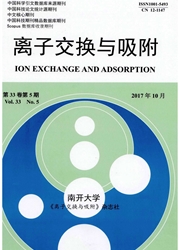

 中文摘要:
中文摘要:
采用Pseudomonas sp.的胞外生物高聚物对Pb(II)进行吸附试验。分别用扫描电子显微镜、X射线能谱仪(SEM-EDX)和傅里叶变换红外光谱(FTIR)对吸附铅前后的胞外生物高聚物进行表征分析,研究了Pb(II)在胞外生物高聚物上的吸附行为。结果表明,Pb(II)的最佳吸附pH值为6.0,其吸附行为符合Langmuir吸附等温模型,最大单分子层吸附容量为34.48mg/g。FTIR及EDX实验结果表明,胞外生物高聚物对Pb(II)的吸附被认为是高聚物表面的活性基团对Pb(II)的络合作用和离子交换机制共同发挥作用。被吸附的Pb(II)可用1mol/L的硝酸定量洗脱。方法检出限为3.6ng/mL,相对标准偏差为2.7%[Pb(Ⅱ):0.05μg/mL,n=9]。在优化的实验条件下,实测了环境水样中痕量Pb的含量,结果满意。
 英文摘要:
英文摘要:
The exopolymers produced from Pseudomonas sp. were used as a novel biosorbent, and characterized using scanning electron microscope (SEM-EDX) and Fourier transform infrared spectrophotometer (FTIR). By means of the determination of flame atomic absorption spectrometry (FAAS), the adsorption behavior of exopolymers for lead ions was investigated. The results showed that Langmuir isotherm fitted well with the experimental equihbrium data, and maximum adsorption capacity was 34.48mg/g. Before and after the adsorption to lead ions by exopolymers, the IR spectra showed that the hydroxyl groups, carboxyl and C-O-C groups were confirmed to be the main active groups that could combine with lead ions; The EDX detections indicated that the mechanism of adsorption was ions-exchange. The adsorbed Pb(II) could be eluted from exopolymers. The detection limit (30, n=9) was 3.6ng/mL, and the relative standard deviation (RSD) was 2.7%. The method was applied to the determination of analysis in environmental water samples, good results were obtained.
 同期刊论文项目
同期刊论文项目
 同项目期刊论文
同项目期刊论文
 期刊信息
期刊信息
